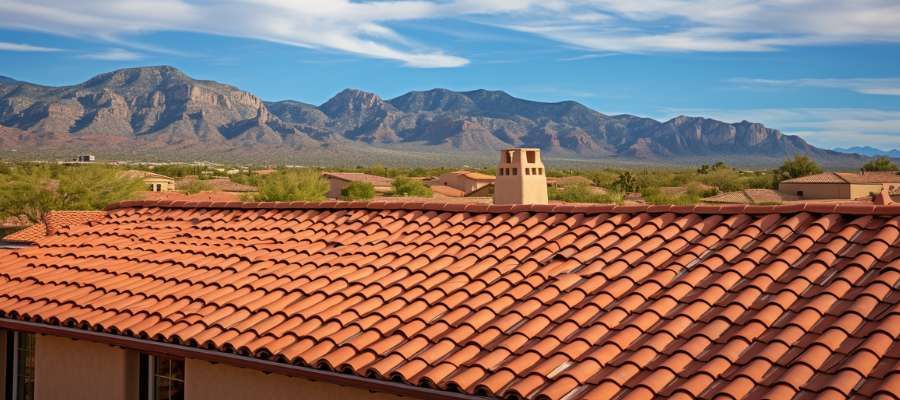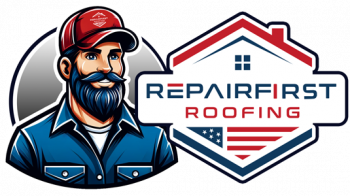Common Roofing Problems in Tucson

In Tucson, the juxtaposition of scorching summers and monsoon storms creates unique challenges for roofing. At Repair First Roofing, we’ve encountered a myriad of issues resulting from our distinct desert climate. Here are the most prevalent roofing problems that Tucson homeowners face, coupled with how our climate plays a role:
1. Sun Damage
The intense Tucson sun can deteriorate roofing materials rapidly.
- Effect: Prolonged UV exposure can cause shingles to become brittle, crack, or fade. Over time, this compromises the roof’s integrity and makes it vulnerable to leaks.
- Solution: Opt for UV-resistant roofing materials and consider periodic roof coatings to reflect the sun’s rays.
2. Missing Shingles
High winds, especially during monsoon season, can dislodge shingles.
- Effect: Without shingles, water can penetrate, damaging the underlayment and potentially leading to structural issues.
- Solution: Regularly inspect your roof, especially after a storm, and replace missing shingles promptly.
3. Punctures and Holes
Apart from debris and weather, desert critters seeking refuge might create roof punctures.
- Effect: These breaches can lead to water leaks and further damage.
- Solution: Monitor for signs of animal activity on your roof, and ensure any gaps or holes are repaired swiftly.
4. Damaged or Dislodged Flashing
Tucson’s temperature fluctuations can cause flashing to expand and contract, leading to damage or dislodgement.
- Effect: Compromised flashing can allow water to seep beneath shingles.
- Solution: Regular inspections can detect faulty flashing early. Repairs typically necessitate the expertise of a professional roofer.
5. Pests in Soffits and Fascia
The warmth of Tucson makes it an attractive habitat for pests.
- Effect: Pests can cause structural damage, compromising the integrity of the roof and potentially infiltrating the home.
- Solution: Regular inspections for signs of pests, combined with prompt repairs and extermination, are key.
6. Blistering
While blistering can occur for various reasons, Tucson’s high temperatures can exacerbate this issue.
- Effect: Blistering can weaken the roof’s structure and lead to more severe problems if not addressed.
- Solution: Depending on the severity, blistering may need immediate professional attention.
7. Pooling Water
Tucson’s sudden downpours can result in water accumulating on flat or low-slope roofs.
- Effect: Standing water can deteriorate roofing materials and lead to leaks.
- Solution: Ensure proper drainage systems are in place and that the roof is appropriately sloped.
8. Thermal Shock
Tucson’s drastic day-night temperature variations can cause materials to expand and contract rapidly.
- Effect: Over time, this thermal shock can weaken roofing materials and create vulnerabilities.
- Solution: Consider roofing materials designed to withstand these fluctuations, and keep a regular check on your roof’s condition.
Conclusion: Tucson’s distinctive climate requires a proactive approach to roofing. At Repair First Roofing, we recommend regular inspections, especially post-monsoon, to ensure your home remains shielded from the elements. By understanding and addressing these common issues early on, homeowners can extend the lifespan of their roofs and safeguard their homes.
Questions & Answers About Common Tucson Roofing Problems
What is the best roof for Tucson, AZ?
Given Tucson’s unique climate with intense sun and monsoon rains, the best roofing options often include tile roofs, metal roofs with reflective coatings, or flat roofs designed with adequate drainage systems. Tile roofs are particularly popular due to their durability, natural insulation properties, and ability to reflect sunlight.
What is a common problem with roof shingles?
In Tucson, one of the most common issues with shingles is sun damage. The intense UV radiation can cause shingles to become brittle, faded, or cracked over time. Additionally, high winds from monsoon storms can dislodge or damage shingles.
What is the number one cause of roof failure?
Improper installation and poor quality materials are often the primary causes of roof failure. In the context of Tucson, failing to account for the area’s specific climatic challenges during installation can lead to premature wear and tear.
What is the most common roof damage?
In Tucson, the most common roof damages are sun-induced deterioration, missing or damaged shingles from high winds, and water pooling on flat roofs after sudden downpours. Over time, these can lead to leaks and structural damage.
How long do roofs last in Tucson?
The lifespan of a roof in Tucson varies based on the material and maintenance. With proper care:
- Asphalt shingles: 15-25 years
- Tile roofs: 50+ years
- Metal roofs: 30-50 years Regular inspections and maintenance can extend these lifespans.*
How can I protect my roof from the harsh Tucson sun?
Consider using reflective roof coatings to bounce back the sun’s rays, reducing UV damage. Additionally, opting for UV-resistant roofing materials and ensuring proper attic ventilation can help mitigate sun damage.
Do flat roofs face more problems in Tucson due to the monsoon season?
Flat roofs can be vulnerable to pooling water after heavy rains. However, when designed with adequate drainage systems and regular maintenance to clear debris, flat roofs can effectively handle Tucson’s monsoon downpours.
Call Repair First Roofing Today to Keep Your Roofing Problems in Check!
Understanding your roof and Tucson’s unique challenges is crucial for longevity and home protection. Regular inspections, quality materials, and a proactive approach to maintenance can make all the difference.
You May Also Like






